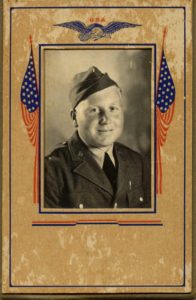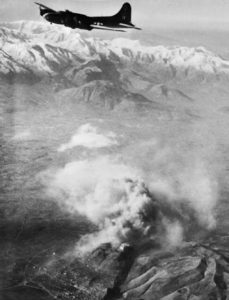The Italian Campaign lasted nearly two years, from July of 1943 to May 1945. Even though the Italian government surrendered and switched sides in 1943, Germany flooded the country with troops, and fought for every inch of Italy like it was Germany itself. Not only did Italians turn on Germany, but the Nazis faced a true international coalition of troops representing numerous nations including the US, UK, Canada, India, Poland, Greece, Brazil, New Zealand, South Africa, France, and Greece.
With its high mountains, rain-swollen rivers, and mud streets that would stop anything on wheels, even Italy’s geography seemed to favor the Germans. With each successive defensive line breached by the Allies, the Germans had prepared another. Nothing would come easy for the Allies in Italy.
My Father would spend most of his time overseas in Italy, taking part in several major actions, including the attack on Monte Cassino. — Harrison Woodard
The Woodard Boys Go to World War II
From Naples To Monte Cassino – Part 4
By Hollis Hood Woodard
(1917 – 2009)
All I could do was pray, and I prayed hard, believing God would protect him.
After we got to Italy, Frank and I decided we had to find H.L. I found out what regiment and company he was in and started looking. First, I had to find the 36th Division Headquarters to find out what section his company was assigned to hold. When I got this information, I went to his company headquarters the first chance I got but missed him by about five minutes. They went into the lines that morning. You can imagine how I felt when I realized my kid brother was up on the front line and in combat. We had talked to other soldiers in the 36th Division and they had told us they were attacking the Germans nearly every day and nearly every day being pushed back. We were able to stay in contact with H.L. through the mail. The mail traveled pretty fast between units there in Italy.
When we first went into the lines there in Italy, we were out in fairly level land, but we could see that the Germans were planning on fortifying the mountains for the Winter. When they moved up into the mountains, that was when our outfit began to have a bearing on the war. The Germans placed their artillery in the mountains and started causing trouble. But once we were set up, we started locating these guns and our artillery would knock them out as fast as we could find them. We used sound and flash to locate their guns. For sounds from their guns we put out microphones that picked up the sound waves when the guns were fired. Back at our command post our computers could take these sound waves and determine where the guns were. Our observers on observation posts could use the flash from the guns at night to compute the location of the guns.
The Germans didn’t understand what was going on and came up with some tricks of their own. They discovered a way to aim their guns at our radio installations. We had a radio unit in a cave and they hit their truck parked out front, which had a fifty caliber machine gun mounted on it and plenty of ammunition. When the shell hit the truck it started a fire that trapped the boys in the cave. One brave soldier crawled to the front end of the truck and fastened a cable to the bumper. We were then able to wench the truck away from the entrance allowing everyone to escape. We had several of our radio installations hit and I am sure they were locating our signal and firing their guns from that information.
You learn fast in combat. Since most of our casualties were from artillery fire, we learned some things to watch for. If you found you were in a bracket you changed your position real quick. If a shell fell short, and the next one went over your head about the equal distance, you were in a bracket and had better move, because the next one would be very close to where you were. Another bracket could be set up by a shell landing to your left and the next one an equal distance to your right. If you saw this happening it was moving time again.
Frank was at an observation post in a cave on one of the mountains. He could see this gun firing and figured they knew they were there and were going to try to knock them out. When one shell fell short and the next one an equal distance over, he yelled for them to get behind a pile of hay because he knew the next one would probably come into the front of the cave. It did and landed where Frank had been standing. It didn’t hurt anyone but we had to send a medic up to pick hay stems out of their arms and faces. They were being supplied by a donkey train, and they had the hay to feed the donkeys.
Some of our hardest fighting was on what they called “The Winter Line” in Italy in the winter of 1943. Men were so high up in the mountains that the only way we could supply them was with donkeys, hence the hay in Frank’s cave. If you were down near the bottom of the mountain it rained most of the time. If you were up near the top you had to deal with ice and snow. The infantry was unable to do much in the mountains with the weather like it was, so our fighting boiled down to artillery duels. I can remember some days when they would be coming so fast that pieces of shells were flying around the air sounding like a bunch of mad bees.
The Germans liked to keep us awake at night. One gun would start at about three in the morning and fire every five or six minutes into the area. They wouldn’t fire at any target just over the area. We would usually try very hard to locate these guns and destroy them with our artillery fire. It was in this area that my fox hole partner and I really had time to fix up a pretty nice place to sleep. We dug our hole deep enough for us to stand up in, and later we were able to fix an upstairs floor for a place to put our clothes and other supplies. As I mentioned earlier, I had the tarp that came off a German truck and could spread it out where that we could ditch around the edges and not be bothered by water.
Combat put a terrible strain on a person. When we got into action, I was cool as a cucumber. But when it was over, and everything settled down, I would take what we called the shakes. I would shake so hard that my teeth would rattle. After I made sure my men were alright, I had to hide and shake. It would usually last about five minutes, and then it would be over. None of the men knew about this except my fox hole mate. He crawled into our fox hole one day with a bad case and told me he was glad that someone else had these things.
Another thing I found was that it was easy to pray when the possibility of your being hit any minute was good. I had the added strain that I was concerned about Frank and H. L. Frank was a cool customer and I was afraid on several occasions that he wasn’t being as careful as he should. The 36th was in the thick of the fighting and I was always concerned about H. L.’s welfare. He aged me several months when he was sent back to North Africa with trench feet.
His regiment was selected to cross the Battle of the Rapido (Gari) River the first winter we were in combat. The night they tried to cross, the river was out of its banks and the Germans held the high ground on the other side. I knew there was trouble when our artillery was ordered to stop firing because some of our men were across the river and they were not sure how they were doing and didn’t want us to hit our men. Later, I learned that those that were across had been driven back across the river. As the dead and wounded were being collected, you can imagine how I felt knowing I had a kid brother up there in that mess. All I could do was pray, and I prayed hard, believing God would protect him.
The next day I located his company. They had lost so many men, and had so many new faces, none of them could tell me what had happened to him. I was relieved when I received a letter from him in a hospital. He had developed trench feet before the river crossing and was in a hospital in North Africa when they tried to cross.
We were in this mountain area most of the winter and sure beat up the towns around us. San Pietro was a small town to our right that the Germans didn’t want to give up. In fact, when they did leave the town it was in a mess. Another little town near San Pietro by the name of Venafro also took a beating. But the little town directly in front of our unit really got tore up. It was Cassino, and it was completely destroyed. One of my Sunday School buddies was in Italy a few years ago and told me that they didn’t go back into Cassino after the war, but instead built a new city off to the side. It would have been dangerous to try to rebuild the city because of shells and bombs in the ground that didn’t explode.
Cassino was in the valley and on top of the hill. In the back of the city was the Catholic Monastery, Battle of Monte Cassino. The Germans had the top of the mountain and we all assumed they were using the high sections of the Monastery as observation posts to fire on our soldiers in the valley. I can remember many mornings crawling out of my fox hole and looking up at it and saying to myself, “You fellows are looking down our throats.”
We heard reports that General Clark was Catholic and didn’t want to bomb or shell the Monastery. Later we found out that maybe the higher ups had decided in order to go further in the valley it had to be eliminated. One night I was out posting guards and noticed that the Australian Artillery was firing shells at the Monastery. The next morning about day break I had to go further up the mountain to another of our batteries to deliver a message. I happened to look back south and could see vapor trails in the sky and as they got closer I could tell it was a flight of B 17s. As they got closer, in fact, overhead I could see that their bomb bay doors were opening and knew that they were going to bomb the Monastery. I had a ring side seat and sat down on a rock and watched them drop their bombs and head back south. There were several flights of B17s in the morning and they were replaced later in the day by medium bombers and fighter bombers.
After the bombing we didn’t have as much trouble with direct hits from artillery shells so we had to assume that they were directing fire from the Abbey.
Part 1 – Part 2 – Part 3 – Part 4 – Part 5 – Part 6 – Part 7 – Part 8
Search for Other Christian Web Sites.





